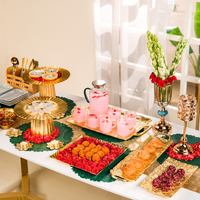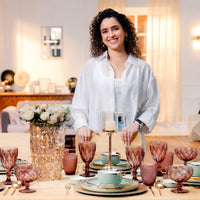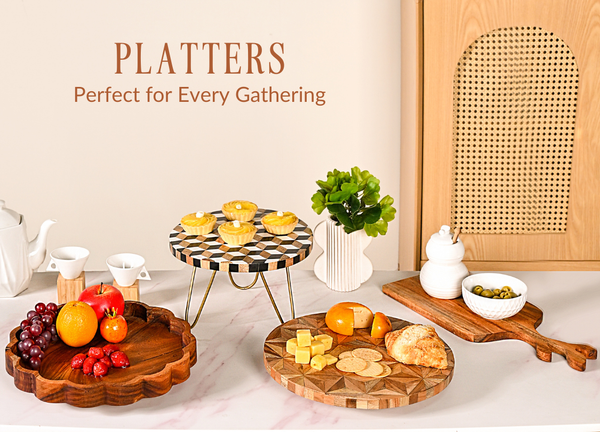Scandinavian design is a design movement that emerged in the early 20th century in the Nordic countries of Denmark, Sweden, Norway, Finland, and Iceland. It is characterised by a focus on simplicity, functionality, minimalism, and an emphasis on natural materials and light colours. The Scandinavian design emerged as a response to the ornate and decorative styles of the time, such as Art Nouveau and Art Deco.
The movement was influenced by various factors, including the region’s natural environment, its social and political values, and its history of craftsmanship. One of the key principles of Scandinavian home decor is the concept of "form follows function". This means that the design of an object should be based on its intended purpose, rather than on ornamentation or decoration. This principle is reflected in the clean lines and minimalist aesthetic of many Scandinavian living room interior designs.
Visit: https://nestasia.in/collections/scandinavian-interior-decorWhy Scandinavian Living Room Decor Is Popular
Scandinavian living room decor has become increasingly popular over the years due to its simplicity, functionality, and stylish design. It typically features a neutral colour palette with a mix of natural materials such as wood, leather, and wool, and minimalist furniture with clean lines. This design style also emphasizes the importance of light, which is why you'll often see large windows and light-coloured walls in Scandinavian living rooms.
This style is particularly popular in smaller apartments or homes because it creates a feeling of spaciousness and openness. Additionally, the focus on comfort and cosiness makes it an inviting space to relax in after a long day. Overall, Scandinavian living room decor combines practicality and aesthetics, making it a timeless and versatile design style.
Characteristics Of Scandinavian Decor
1. Use Of Light Colours
The use of light colours is a fundamental aspect of Scandinavian decor. This design style favours a light and airy feel to a space, and light colours help achieve this effect. In Scandinavian design, the colour palette typically consists of soft, neutral hues such as white, beige, light grey, and pastel colours. These colours create a serene and calming atmosphere that is essential in Scandinavian decor.
By using light colours, Scandinavian designers can maximize the amount of natural light in a space, making it feel brighter and more spacious. Moreover, light colours in Scandinavian decor serve as a backdrop for other design elements, such as natural materials like wood, leather, and wool. These materials can be highlighted against a light-coloured wall or floor, creating a harmonious and balanced look.
2. Use Of Natural Materials
The use of natural materials is one of the hallmarks of Scandinavian design, and it is integral to creating a warm, welcoming, and cosy atmosphere in a space. Natural materials, such as wood, leather, wool, and linen, are favoured in Scandinavian design because they reflect the region's natural environment. Scandinavian countries are known for their stunning landscapes, including forests, mountains, and fjords, and the design philosophy reflects a deep appreciation for the natural beauty of the region.
Wood is a particularly important material in Scandinavian design. It is often used for flooring, furniture, and decorative accents. Wool and linen are the preferred fabrics in Scandinavian design. They are soft, natural, and breathable, making them ideal for cosy blankets, throw pillows and bedding. They also add texture and visual interest to a space.
3. Minimalist Decorations
The design philosophy of Scandinavian living room decor focuses on minimalism. Scandinavian design embraces the concept of "less is more," which means that every element in space should have a purpose and a function. This approach leads to a clutter-free, organized environment that feels calming and peaceful.
Decorative accents in Scandinavian design are chosen with care, with a few well-placed items used to create visual interest. Plants, neutral-coloured showpieces and simple artwork are popular decorative elements in Scandinavian decor. These elements bring a sense of warmth and texture to a space without overwhelming it.
4. More Natural Light
The Nordic region is known for its long, dark winters, and the importance of natural light is deeply ingrained in the Scandinavian lifestyle. The use of natural light in design is not only practical, but it also plays a significant role in creating a warm, inviting atmosphere. Scandinavian decor often features large windows that let in as much natural light as possible. Natural light is also known to improve mood, increase productivity, and promote better sleep.
To maximize the effects of natural light, Scandinavian design often incorporates light-coloured walls, floors, and furnishings. These light, neutral colours help to reflect and amplify the natural light, creating a bright and airy environment. In addition to large windows, the Scandinavian design also incorporates other elements that maximize the effects of natural light. Mirrors are also used to reflect light and create the illusion of more space.
5. Hygge
Hygge (pronounced "hoo-ga") is a Danish word that describes a feeling of cosiness, warmth, and contentment. It is a fundamental element of Scandinavian decor and lifestyle, and it is essential for creating a welcoming and comfortable atmosphere in a space. In Scandinavian decor, Hygge is achieved by using soft, natural materials, warm lighting, and comfortable furnishings. Textured fabrics are commonly used to create a sense of warmth and comfort while providing softness to a space, creating a cosy and inviting atmosphere.
Warm lighting is also essential for creating hygge in Scandinavian decor. Soft, warm light sources, such as candles or dimmed light fixtures, create a relaxing and comforting environment. The lighting is often arranged in layers, with multiple light sources used to create a warm and welcoming ambience. Comfortable furnishings, such as plush sofas, and armchairs, are also essential for creating hygge in Scandinavian decor. These pieces are designed for relaxation and comfort, with soft cushions and warm blankets to snuggle up in.
Mistakes To Avoid
1. Using Too Many Bright Colours
Scandinavian decor is characterised by simplicity and minimalism. This design aesthetic aims to create a calming and peaceful environment. While pops of colour can be used sparingly to add interest and texture, using too many bright colours is generally not recommended in Scandinavian design. The reason for this is that bright colours can be overwhelming and distracting, which is contrary to the calming and peaceful atmosphere that Scandinavian design aims to create.
2. Not Incorporating Natural Materials
Natural materials are integral to the Scandinavian design aesthetic, and not using them would be a departure from this style. The use of natural materials is essential in Scandinavian decor because it is closely tied to the concept of hygge, which roughly translates to a feeling of cosy contentment and well-being. Natural materials are also durable and long-lasting, which goes with the sustainability aspect of Scandinavian design.
3. Over-Decorating
Over-decorating the living room is not in line with the Scandinavian design aesthetic and can detract from the overall style of the space. The goal of Scandinavian decor is to create a harmonious and balanced space that promotes relaxation and well-being. Overdecorating the living room with too many accessories, furniture pieces, or decorative items can disrupt this balance and make the space feel cluttered and overwhelming.
4. Blocking Natural Light
Scandinavian design emphasizes the use of natural light to create a bright and airy atmosphere that promotes relaxation and well-being. One of the main reasons for this is that natural light helps to highlight the natural materials and neutral colour palettes that are integral to Scandinavian design. When natural light is blocked, the space can feel dark and closed off, which can detract from the overall style and mood of the room. In addition to this, natural light has numerous health benefits, including boosting mood, improving sleep, and reducing eye strain. Scandinavian design aims to create a space that promotes well-being, and natural light is a key aspect of this.
When designing a Scandinavian living room, it is important to focus on creating a sense of openness and airiness through the use of light colours, natural materials, and simple, functional furniture. Whether you are a fan of minimalist design or simply looking for a fresh, modern look for your living room, Scandinavian decor offers a unique and stylish approach that is both practical and aesthetically pleasing. By following these key principles of Scandinavian design, you can create a warm, welcoming, and stylish living room that is both functional and beautiful.
Frequently Asked Questions
1. What colours should I use in a Scandinavian living room?
A: Scandinavian home decor typically favours a neutral colour palette, with shades of white, beige, and grey being common choices. Accents of black and muted blues or greens can be used to add some contrast and depth to the space.
2. How can I add texture to a Scandinavian living room?
A: Texture is an important element in Scandinavian decor, as it helps to create a cosy and inviting atmosphere. You can add texture to a Scandinavian living room by incorporating materials such as linen, and vegan leather, as well as natural fibres like jute and grass. Textured throw pillows, blankets, and area rugs are also great ways to add texture to the space.
3. How can I incorporate plants into a Scandinavian living room?
A: Plants are a great way to bring some life and colour into a Scandinavian living room. Look for low-maintenance plants like succulents or snake plants, and display them in simple, minimalist planters. Hanging plants can also be a great way to add some visual interest to the space.

































